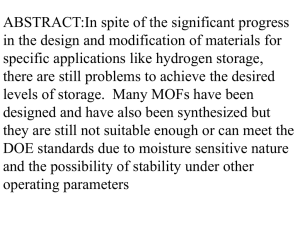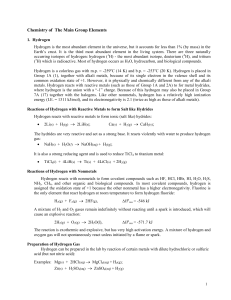22 Chem of Hyd. Oxy. Nitrogen and Carbon
advertisement
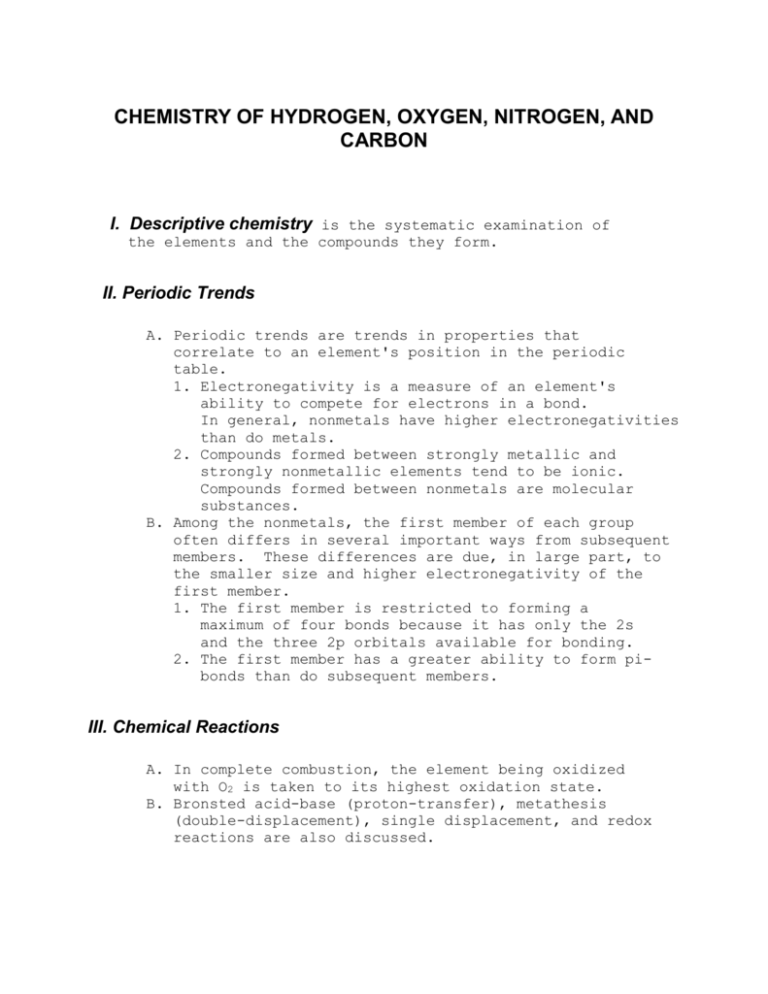
CHEMISTRY OF HYDROGEN, OXYGEN, NITROGEN, AND CARBON I. Descriptive chemistry is the systematic examination of the elements and the compounds they form. II. Periodic Trends A. Periodic trends are trends in properties that correlate to an element's position in the periodic table. 1. Electronegativity is a measure of an element's ability to compete for electrons in a bond. In general, nonmetals have higher electronegativities than do metals. 2. Compounds formed between strongly metallic and strongly nonmetallic elements tend to be ionic. Compounds formed between nonmetals are molecular substances. B. Among the nonmetals, the first member of each group often differs in several important ways from subsequent members. These differences are due, in large part, to the smaller size and higher electronegativity of the first member. 1. The first member is restricted to forming a maximum of four bonds because it has only the 2s and the three 2p orbitals available for bonding. 2. The first member has a greater ability to form pibonds than do subsequent members. III. Chemical Reactions A. In complete combustion, the element being oxidized with O2 is taken to its highest oxidation state. B. Bronsted acid-base (proton-transfer), metathesis (double-displacement), single displacement, and redox reactions are also discussed. IV. Hydrogen A. Hydrogen is the most abundant element in the universe. There are three isotopes: protium (no neutrons), deuterium (one neutron), and tritium (two neutrons). B. Hydrogen is the only element that is not a member of a family in the periodic table. Hydrogen forms both a cation, H+, and an anion, H-. The properties, preparation, and uses of hydrogen are given. C. Hydrogen forms three different types of hydrides. 1. Ionic hydrides are formed between hydrogen and the alkali metals and alkaline earth metals. 2. Metallic hydrides are formed between hydrogen and transition metals. The metallic properties of the metal are preserved in the hydride. 3. Molecular hydrides are formed between hydrogen and nonmetals or semimetals. D. "Chemistry at Work: Using Metal Hydrides" examines research for using hydrides as storage media for H2. Discussion Question: Why is hydrogen so abundant in the universe but so comparatively uncommon on earth? V. Oxygen A. Oxygen is the most abundant element in the earth's crust and in the human body. Oxygen occurs in two allotropes, molecular oxygen O2 and ozone O3. The properties, preparation, and uses of oxygen, O2, are given. B. Ozone was discussed in detail. C. Oxides are oxygen-containing binary compounds in which oxygen is in the -2 oxidation state. 1. Acidic anhydrides or acidic oxides contain a nonmetal combined with the oxygen. 2. Basic anhydrides or basic oxides contain a metal combined with oxygen. 3. Amphoteric oxides can exhibit either acidic or basic character. D. Peroxides contain an -O-O- unit with each oxygen in a -1 oxidation state. Superoxides contain an -O-O-unit with each oxygen in a -1/2 oxidation state. E. The oxygen cycle is a term applied to oxygen's repetitive collection, use, and return to the environment. Discussion Question: Why might hydrogen peroxide burn your skin? VI. Nitrogen A. The properties, preparation, and uses of nitrogen, N2, are given. B. Ammonia can be produced in the laboratory by the action of NaOH with NH4Cl. Commercially, ammonia is produced by the Haber process. C. Nitrogen forms three common oxides and two common oxyacids. The properties, preparations, and uses of these compounds are given. 1. Nitrous oxide (N2O), nitric oxide (NO), and nitrogen dioxide (NO2) are the three oxides. Nitrogen dioxide dimerizes at low temperature, yielding N2O4. 2. Nitric acid, HNO3, is a strong oxidizing agent and is produced by the Ostwald process. Nitrous acid, HNO2, is a weak acid. D. Nitrogen has a cycle of use and regeneration in nature called the nitrogen cycle. VII. Carbon A. We often refer to compounds of carbon that have no C-H bonds as inorganic carbon. B. Carbon exists in several elemental forms: graphite, diamond, carbon black, charcoal, and coal. C. "Chemistry at Work: Carbon Fibers and Composites" shows how carbon is used in structural materials. D. There are two oxides of carbon and several compounds based on the carbonate ion, CO32-. 1. The environmental hazards of CO were discussed. CO is a good reducing agent. 2. Carbon dioxide is produced when carbon-based fuels are burned in excess oxygen and when carbonates are heated or treated with acid. E. The only oxyacid of carbon is carbonic acid, H2CO3, which results from dissolving CO2 in water. Carbonate minerals are very common, particularly calcite or common limestone, CaCO3. F. Binary compounds of carbon with metals, semimetals, and certain nonmetals are called carbides. 1. Ionic carbides or acetylides, C22-, are formed with electropositive metals. 2. Interstitial carbides are formed with transition metals. 3. Covalent carbides are formed with boron and silicon. Discussion Question: Which element, C, O, or H, seems to be the most important element and why? SAMPLE QUIZ QUESTIONS 1. What are the components of water gas, an important industrial fuel? 2. What is meant by the term interstitial hydride? 3. Different forms of the same element in the same physical state, such as O2 and O3, are known as _________________. 4. Write balanced chemical equations for the following reactions: (a) Sodium oxide is dissolved in water; (b) Calcium hydride is dissolved in water; (c) Sodium peroxide is dissolved in water; (d) KClO3(s) is heated; (e) CaCO3(s) + H+(aq) -->; (f) Zinc metal reacts with sulfuric acid. 5. Give the chemical formula for: (a) hydrazine; (b) ozone; (c) calcium carbide. 96 6. List two general ways that the first member of a periodic family differs from subsequent members. 7. Describe, using chemical equations, the preparation of nitric acid, starting with N2, H2, O2, and water. 8. Classify the oxides from the following elements or groups as acidic, basic, or amphoteric: (a) Al; (b) alkali metals; (c) halogens; (d) Ba; (e) S. 9. Give the name and formula of a compound that contains the: (a) peroxide ion; (b) superoxide ion; (c) hydride ion. 10. List one commercially important reaction of each of the following: (a) H2; (b) NH3; (c) CaC2. 97




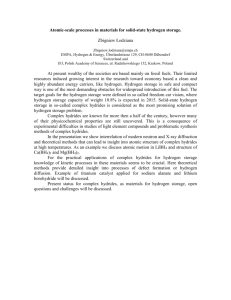
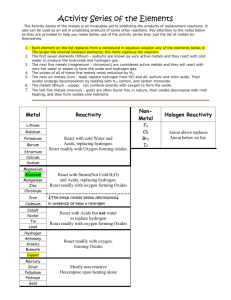

![DIRECT SYNTHESIS OF Li[BH4] FROM THE ELEMENTS](http://s3.studylib.net/store/data/006749722_1-3acc3b7e04414ccf23cb4364d250a1e7-300x300.png)
